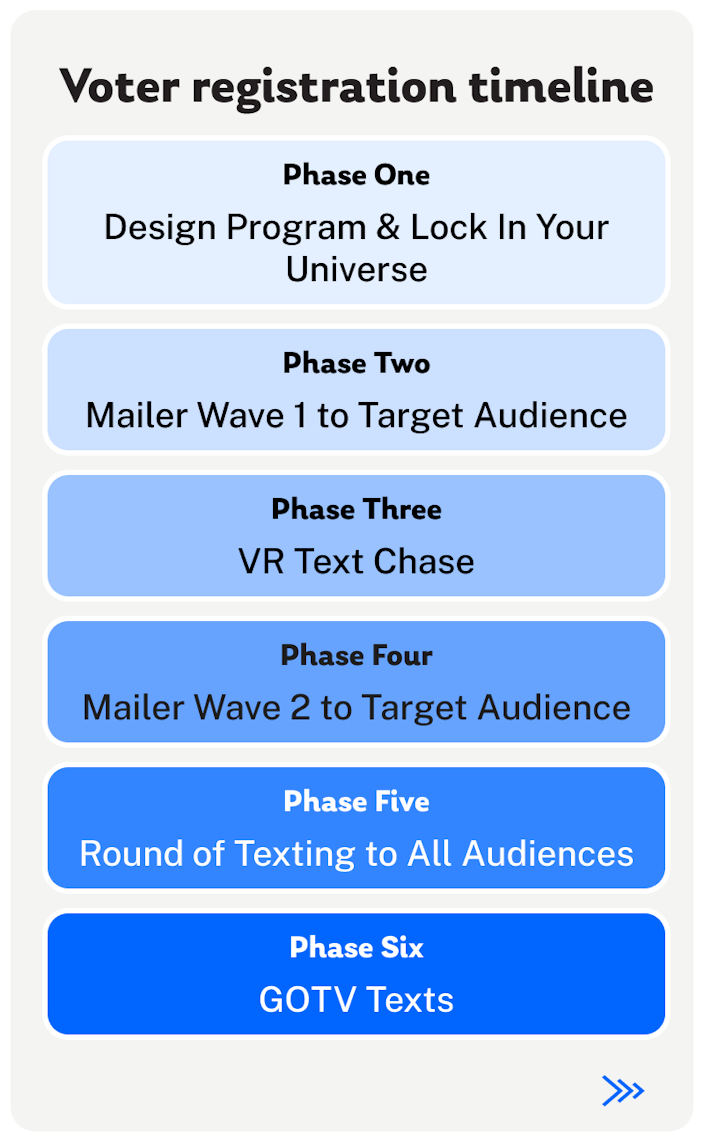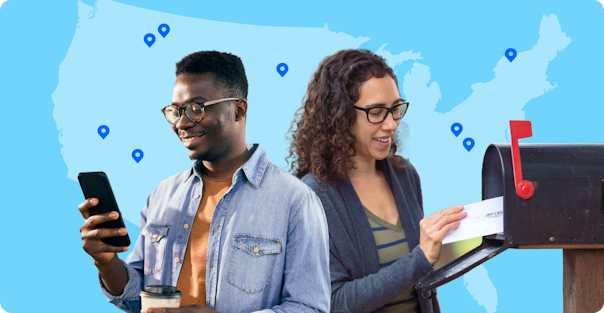Introduction
Based on our years of success with organizations like the Beto for Texas, Cori Bush for Congress, the Connecticut Democratic Party, Rust Belt Rising, and You Can Vote, we’ve created a voter registration timeline that is ideal for voter engagement and turnout. With so much on our minds during a crucial election year, we hope this blog is a resource during your busy election season.
We’ve also included a helpful image of this timeline to make it easier to add to your files for voter registration planning!
Why voter registration?
In recent years, Democrats have relied upon nonprofits for voter registration and dedicated few resources to partisan-based voter registration. Nonprofit investment in voter registration has dramatically declined since 2020, with many organizations dedicating a small fraction of the resources they did in past cycles. In 2022, many major C3 and C4 organizations did not run voter registration programs at all.
As a result, 2022 had the fewest registrations nationwide in a midterm year since 2014, and 2023 had the fewest registrations of any year since 2013.
Meanwhile, the Republican registration is surging in key battleground states like Arizona and North Carolina.
Civitech has built the most advanced and cost-effective multi-channel voter registration program to identify and engage new voters — then register and get them to the polls.
Margins of victory can be so small that a voter registration campaign, especially with a texting chase program, can provide the final push needed to reach your win number. Plus, a combination of mail and text chase programming can be much more economical than in-person voter registration campaigns.
Why start voter registration so early?
The best time to begin planning a voter registration campaign is at least three months before the registration deadline.
At Civitech, we’ve not only run multi-channel voter registration programs but have studied and analyzed the results using randomized control trials (RCTs) to determine which tactics work and which we should leave behind.
In our studies, our data scientists have found that registration peaks 15-20 days after a voter registration mailing, with most of the registrations happening within two months. Most folks also want to account for at least two to three weeks before mailing for planning, design, review, and printing. This means that if your state has a registration deadline in the first week of October, you ideally want to start planning your mail program the first week of July.
Starting voter registration programs early is vital to account for the time it takes folks to fill out and mail back voter registration forms. If you start earlier, you can also create additional touchpoints and opportunities for conversation with your new voters. Also, if you start a voter registration program six to nine months before the general election, it gives you the space to talk to voters during all the phases of a campaign, including the introductory phase, the primary, persuasion, mobilization, and GOTV.
An ideal voter registration timeline for 2024

Summer
July 2024 - Program Kick-Off
Establish clear goals and target audience: Collaborate with the Civitech team to define your goals, understand your potential voter base, and determine the size of your target universe. For campaign organizers, this may involve analyzing the electorate and identifying the number of votes needed for victory. On the other hand, non-profit organizations can focus on specific geographic areas or constituencies, gaining insights into the unregistered population to set achievable goals.
Craft compelling mailers: Once you identify your goals and target audiences, we collaborate with you to create impactful mailer inserts. Our expertise ensures that we incorporate industry standards and tested best practices into your efforts. The elements could include social pressure elements, expressing urgency, highlighting the simplicity of the registration process, and even pre-filling accompanying forms. Additionally, the mailers can feature candidate photos, campaign logos, submission deadlines, relevant iconography, and more. We provide guidance and handle all design work, ensuring your mailers make a lasting impression.
Print and mail: After the mailer elements are designed and approved, we move on to the print phase. We meticulously package the data with inserts, and forms and send them to the print house, where they turn the data into a scannable barcode. Our close collaboration with the print shop ensures our rigorous quality standards are met. Once all materials are printed, they are promptly mailed or drop-shipped to the relevant addresses.
August 2024
Track and engage: Our comprehensive mail dashboard allows you to track every piece of mail throughout the entire process, from mailing to delivery. This transparency enables you to monitor the journey of each individual envelope until it reaches its destination.
Upon delivery confirmation, we take it a step further by sending a text message to the recipient, ensuring they have seen the mail and offering assistance with form completion if needed. Our research has shown that engaging recipients through multiple channels significantly enhances the effectiveness of our efforts. We also encourage you to incorporate the data into your existing outreach strategies, such as phone banks or canvassing, for further impact.
In addition to tracking delivery, we can monitor application returns.
Fall
September and October 2024
Texting Outreach: Two weeks before your voter registration deadline, we recommend reaching out to potential voters again. We have carefully tested texting scripts to encourage folks to submit their voter registration forms with the pre-stamped envelopes we provide.
Get-Out-the-Vote Texting: You can also incorporate GOTV texting to newly registered voters before voting starts. Ideally, you’ll want to plan out your GOTV ahead of the final crunch with a series of outreach. There’s no shortage of ways to contact voters and drive action through texting. While we are providing general advice, make sure to check your registrar and state board of elections for the specific laws and regulations that guide your campaign as it relates to texting and voter contact. Learn about GOTV texting program best practices and more in our blog article: How to Use Texting to Build a Winning GOTV Program.
Standard GOTV: The most basic type of GOTV texting campaign. You contact supporters and voters who fit the profile of your supporters. Give the potential voters information about their polling location, voting hours, and key dates. Candidates and organizations typically run these types of campaigns the weekend before Election Day and up until the polls close. For many folks, Election Day signifies the day to get out and vote. Use this momentum to your advantage! Send reminders on Election Day to turn out voters at the final hour.
Early Voting: The addition of early voting in many states gives voters more opportunities to cast a ballot, and you also have an additional opportunity to reach voters before they cast a ballot. And if someone votes early, that’s one less voter to worry about on Election Day. An early voting campaign should include key information like hours and locations. Make sure you contact voters right before early voting starts (dates vary by state).
GOTV + Tripling: Recommended response scripts make it easy to ask your identified supporters to also engage their friends and community. Texters can ask contacts to “vote triple” by reminding their friends, family, and housemates to vote too.
Volunteer ask: If you have a list of known supporters, you can send a follow-up text asking if they’d like to volunteer with the campaign. You’ll have more success with asking for a specific event or task, but you could also share your general volunteer sign-up if someone shows interest. Ideally, you’ll want to run a volunteer ask campaign after your first round of texting, but not too close to Election Day, or there won’t be time to volunteer.
Multiple candidates: GOTV efforts can highlight more than one candidate or race. Many organizations and state parties run campaigns that promote voting for multiple candidates up and down the ballot. Some even share example ballots that make it easy to vote.
Ballot chase with vote-by-mail lists: If you’re running an absentee ballot program, you can reach out to voters who have received a ballot and haven’t returned it yet. Staying on top of outstanding ballots can help ensure they are returned on time. If deadlines have passed for voters to mail a ballot, you can suggest alternative ways to vote, such as returning the ballot to a drop box or in-person voting. These efforts can make sure no one is left out of the civic process. Follow-up is essential!
Post Election
Once your voter registration is complete and Election Day is over, we will provide you with a full program analysis once the vote history file is available from the state. We work with you to find successes with your program and areas of improvement for future programs. We can discuss strategy with you as your audience has expanded for future elections.



